The below text and images are taken and adapted from Grahame L. Walsh’s 2000 publication, Bradshaw Art of the Kimberley.
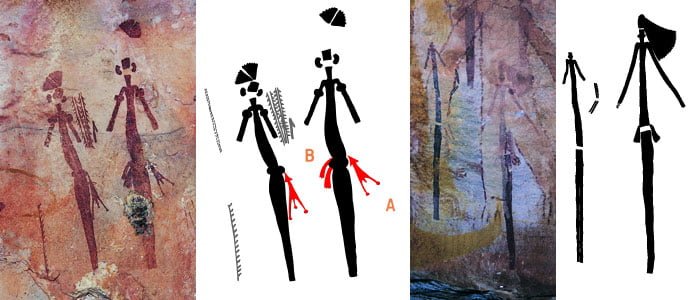
Human form persists as the dominant theme, but adopts dramatically different appearances. The CPF Period heralds not only markedly different depictions of human form and associated colour use, but notable changes in many elements of dress, weaponry and most particularly headdress. Multi-Barb Spears become a common weapon, frequently accompanied by a spearthrower, and boomerangs are still frequently carried.
Figures appear to continue to represent ‘real people’ rather than ‘deities’, but with increasing degrees of schematisation, which eventually parallel levels of idealisation exhibited in the earlier Tassel Bradshaws.
Initially figures are shown with a distinctive variation of the earlier Three Point Sash, common to the Sash Bradshaws. Although Barbed Three Point Sashes had developed, the new forms are almost exclusively shown with small knobs added to the three points of their sashes, which are referred to as Knobbed Three Point Sashes (A). These continue to have the same mounting alignment as the Sash Bradshaw, from the upper edge of the Cummerbund Waistband, and to the ‘rear’.
They are commonly associated with a small Pubic Apron mounted to the ‘front’ (B), and the rear sash is later commonly replaced with another rear-mounted Pubic Apron.
Some of the more elegantly portrayed transitionary forms show strong links with the preceding Stylised Bradshaws, and are some of the last Erudite Epoch figures to commonly display variations of the long standing Dunce Cap Headdress (A). During these transitionary times, the broad-spaced form of Multi-Barb Spear appears favoured, and may represent the originally developed form. Examples can be seen on this northern figure and also on a southern transitionary form shown in ‘B’. The southern forms often display a colour/element convention common to the transitionary times which now creates an initial impression that individuals are wearing trousers.
A polychrome profile view of a Bradshaw/CPF transitionary form (C), retaining basic semi-naturalistic body characteristics from earlier forms, but including the bichrome forearms and distinctive Busby Headdress common to later ‘classic’ CPF developments.
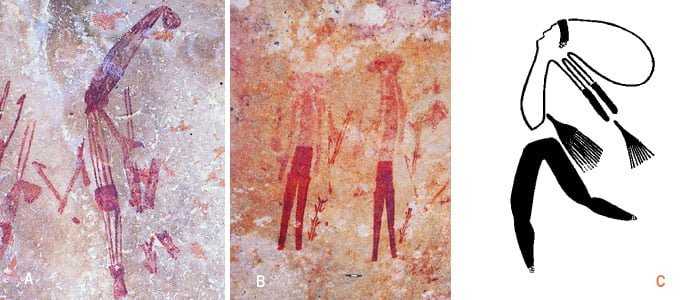
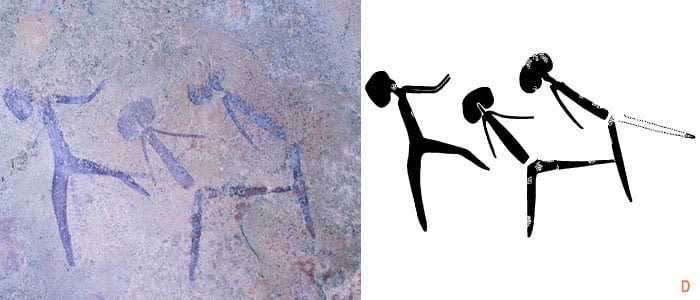
In ‘D’, a discrete group scene shows important detail of plan and profile alignments in static and action stances. The basic semi-naturalistic body elements and Stick Arm attributes of the Elegant Action Figures are accompanied by the appearance of Cashew Headdress variations.
The yellow face band makes its appearance very early in the sequence, when CPF still displayed significant semi-naturalistic characteristics.
Early semi-naturalistic CPF forms are primarily of solid red infill. These forms appear to predate introduction of the yellow face band convention, but show that the white forearms and feet convention is already in vogue (A). Even so, the yellow face band makes its appearance very early in the sequence, when CPF still displayed significant semi-naturalistic characteristics (B).
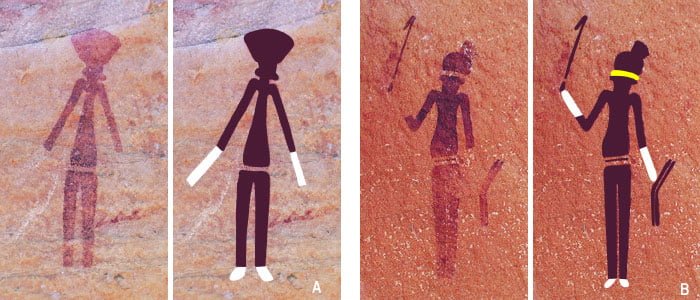
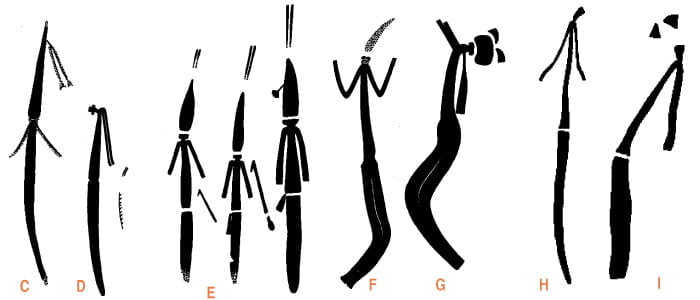
A very limited overlap of vertical Dunce Cap forms persists in some transitionary CPF forms. A plan view example of the late transitionary forms of Stylised Bradshaws, showing the erect Dunce Cap (C) Headdress and slim arms. In ‘D’, the horizontally aligned head and headdress convention of profile view is shown, together with the developing bichrome forearm convention, now appearing as ‘missing’ sections. The plan view transitionary figures in ‘E’ show the development of the bichrome forearm and yellow face band common to later ‘classic’ CPF. However, the three figures (E) retain strong links with the Mantis Bradshaw-to-Schematised Bradshaw silhouette with a slim cigar-shaped body topped by an erect, slim, Dunce Cap Headdress.
Dunce Cap Headdress variations disappear from the art with the stylised Mantis and transitionary Bradshaw forms, and remain absent in Kimberley art for the rest of time.
The disappearance of the Dunce Cap variation headdress would thus appear important in assisting transitionary studies. In ‘F’ and ‘G’ we see a plan and a profile stance of a similar quite distinctive form of figure, showing the presence of the earlier Dunce Cap Headdress on the plan view (F), and a common later CPF form involving the Cashew/Busby Headdress on the profile view in ‘G’. Both figures display obvious ‘missing’ face band sections, forearms and feet, characteristics of classic CPF, while retaining many characteristics of an ‘animated’ form of Stylised Bradshaw, rather similar to ‘C’ and ‘D’.
Examples of transitionary forms of Clothes Peg Figures in which the arms still remain monochrome single units, predating development of the white forearm tradition which became synonymous with this group. The 690x150mm profile figure in ‘H’ once had the last variation of a Dunce Cap Headdress, with one Broad Tussock mounted on the upper mid-section, and the other suspended as a Tassel Tip. The distinctive slight curve of the monochrome forearms is particularly evident on the 850×117 plan view figure in ‘I’.
Static CPF
Although monochrome forms dominate Static CPF depictions, bichrome was used and even extended to the associated miniatures (A). The original use of bichrome is now most evident in ‘missing’ face band and some forearm sections. Forearm depiction, interestingly, can involve a range of combinations:
1 All monochrome red, as in the preceding Bradshaw art,
2 One-Only-Bichrome-Arm, forearm originally white,
3 Both arms bichrome, forearms originally white.
Detail of forearm colour variation may initially appear insignificant, but it seems important in determining the sub-groups and transitionary variants associated with the development of the white forearm convention, a feature which becomes synonymous with all ‘classic’ CPF until the collapse of the Erudite Epoch. In ‘A’, the figures in the right-facing trio arrangement are examples clearly showing the One-Only-Bichrome-Arm convention.
quence, when CPF still displayed significant semi-naturalistic characteristics (B).
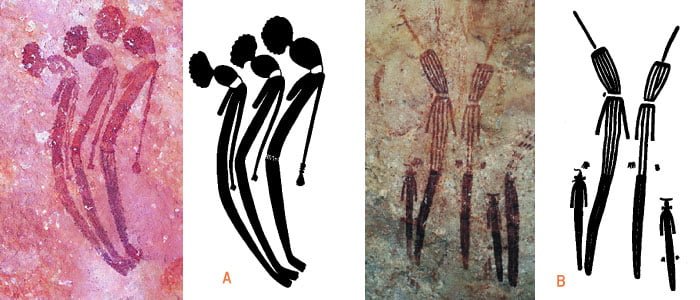
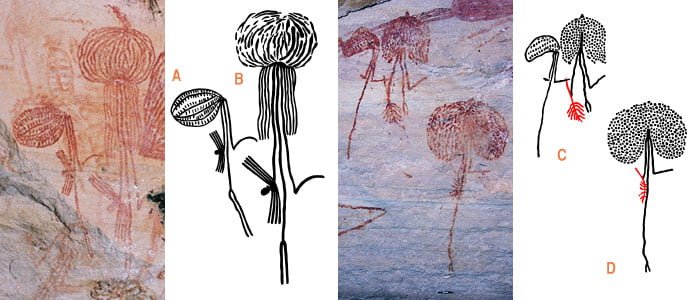
Fine digit detail is included at times, such as the finger detail in ‘B’ and toe detail in ‘C’. Most Static Clothes Peg Figures are shown without any indication of activity, being most commonly depicted in static alignment with hanging arms. An important iconographic key indicating activity is the infrequent presence of slightly angular boomerangs. Boomerangs appear to be the only artefact depicted, and invariably appear as one weapon per individual. Boomerangs are consistently held by the tip suggesting an action rather than a transporting position, but the fact that the weapon is held by both hands indicates a ritual rather than functional activity. The convex sweep of the boomerangs can be in the aggressive (forward) or passive (rear) alignment (C). An assessment of known encoded iconographic information suggests that the Static CPF indicate group scenes involving hierarchal order, with a passive and probably ceremonial theme. Their time in Kimberley art history certainly precedes the aggressive themes synonymous with fully developed CPF forms, where combinations of weapon-laden individuals depicted in challenging stances becomes the standard portrayal.
Plan view alignments dominate this sub-group, but aesthetic profile arrangements occur (C). Large-And-Small Arrangements are common (B, C, D ), where the miniature figures all appear to be males of approximately 50 per cent of the size of their dominant associates.
Elbow-length Tasselled Cords are commonly featured suspended prominently from the lower head area, as in ‘E’ and ‘F’. A variation of a Tasselled Cords arrangement base-mounted headdress occurs as an apparently regional variation of Tassel Bradshaws from the north-east region, and the Static CPF accoutrements may well be a regional continuation of this trend.
Spears are noticeably absent from Stick CPF depictions. A discrete Large-And-Small Stick Clothes Peg Figure Arrangement where a plan view secondary figure (A) is typically aligned facing the dominant 360mm figure. The recurring Mango Headdress form, as shown on the secondary figure, may represent a profile impression of the plan view Pumpkin Headdress on the dominant figure (B). In this depiction multiple arm-length pendulous cords are suspended from the headdress underside.Examples of large or angular boomerang forms appear non-existent. Most male figures hold at least one boomerang, which is almost invariably held by the tip in the ‘action mode’, and in ‘aggressive alignment’. Frequently a cluster of three to five reserve boomerangs are held in the ‘transport mode’ in the opposite hand. Dominant and more elaborate figures in group scenes commonly clutch a small rounded object with their reserve boomerangs, presumably representing a small Dillybag (A and B). This appears an artefactual legacy from the earlier Elegant Action Figures, who are commonly shown holding a similar small ‘bag’ in a similar manner.
Less identifiable schematised objects are also recurring elements, such as the ‘fernleaf’ shape, which is often in association with a short straight ‘stick’ or ‘baton’, as in ‘D’. Stick Clothes Peg Figures showing headdress variations. The larger (350mm) plan view figure ‘D’ wears an Umbrella Headdress, while the small ‘fernleaf’ object is commonly held by dominant figures. The smaller figures ‘C’ include plan and profile views of different headdress.
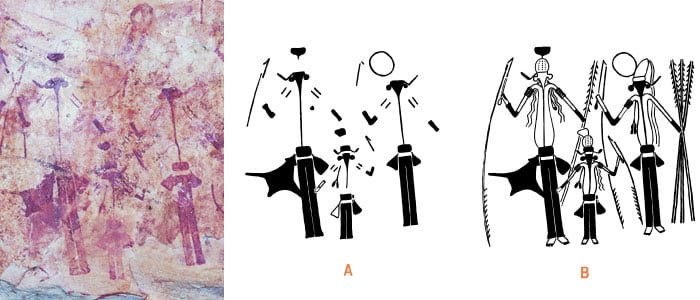
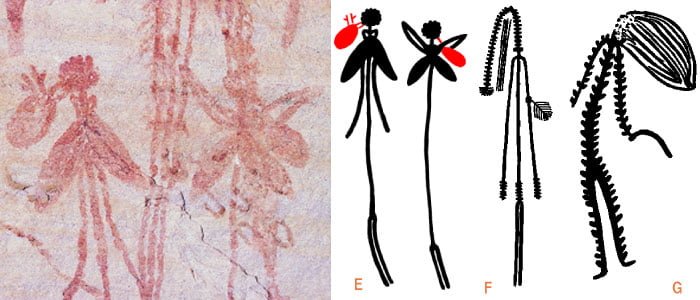
Females are identified by exaggerated Breasts-To-Either-Side of the body and short rounded hair silhouette. Female associated ‘held’ objects include Dillybags suspended from a head band. Occasionally, additional subtle detail will indicate the container’s contents and, in the detail of (E), schematised macropod rear hoppers can be seen protruding from the left figure’s bag.
Stick Clothes Peg Figures, where the standard ‘stick’ form in ‘F’ has exceptionally lavish additional wrist, waist and headdress decorations. The Barbed Body variation can be found on males (G) and females. The female incorporates an arm alignment favoured by this group, sweeping arms in close to the chest to permit clear gender identification by exaggerated breast silhouettes. Barbed Body variations may show legs (G), or the more common female form of extended legless torsos.
Group scenes of Stick Clothes Peg Figures involving males and females in plan and profile views. A discrete panel of Stick Clothes Peg Figures (H). The Side-By-Side Pair of males share similar decoration, weapons and alignment. The artist appears to have used the Large-And-Small Arrangement to show status differentiation in the recorded ‘story’.
In ‘I’ a far north-east style shows the female devoid of headdress leaning over to clutch a dominant male. In ‘J’ the dominant Face-To-Face Pair of males are in profile view while secondary male and female figures stand in plan view to the left.
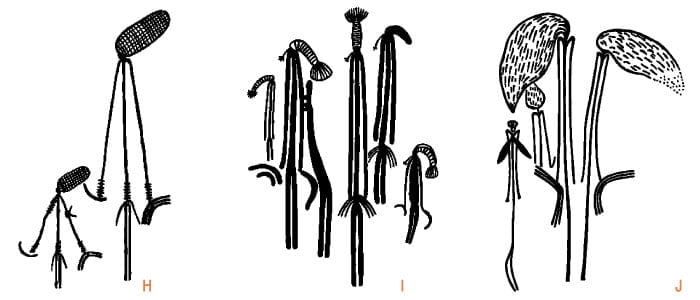
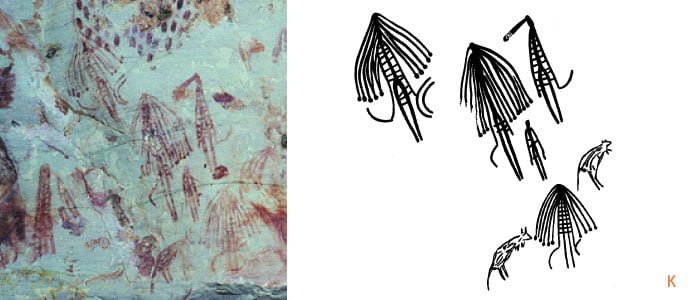
Part of a group scene of plan view Stick Clothes Peg Figures (K), ranging in height to 330mm. Their uncommon association with plan view marsupials suggests secular activities. Although the figures in these Large-And-Small Arrangements wear two quite different forms of headdress, all carry boomerangs, suggesting that even those with buttock-length tasselled-cord headdress are male.
A 140x810mm discrete scene of Stick Clothes Peg Figure art (L). Approximately 29 schematised macropods are shown rising from a single point and speeding away to the right. Part of a separate large group scene of miniature males and females can be seen to the above right.
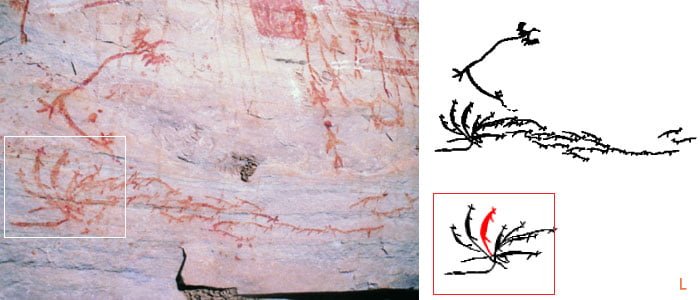
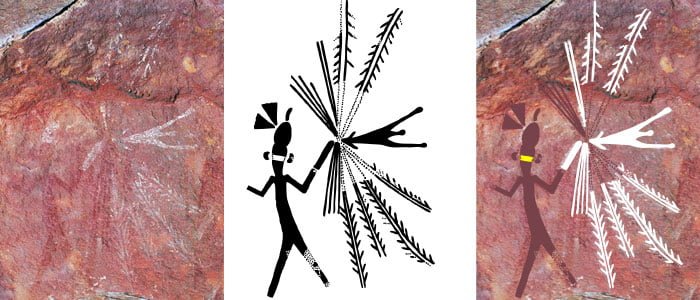
Fortunately, artists occasionally reversed the colour/element conventions designated for consistently recurring forms, providing rare records of normally vanished sections to survive in red. The value of the inventory established through the incidence of the reverse colour/element convention can be appreciated by studying ‘A’ and ‘B’ . The accompanying graphic in ‘A’ shows the identifiable surviving elements, while ‘B’ shows a hypothetical reconstruction of at least the primary original form, which may well have been even more complex and detailed.
A 340x200mm panel (C), showing a remarkable example of preservation of reverse to normal colour. The red figure has almost vanished, but considerable amounts of the normally missing white paint survive. Some appreciation can be gained of the amount of information lost from the innumerable now monochrome red Clothes Peg Figures, standing now with outstretched empty hands. In one hand alone, this figure holds a radiating bundle of at least 12 Multi-Barb Spears, and a hand-held Knobbed Three Point Sash.
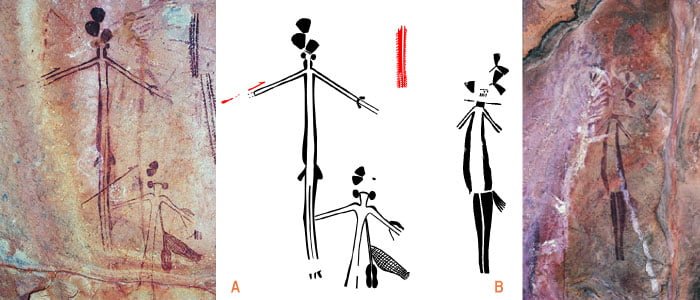
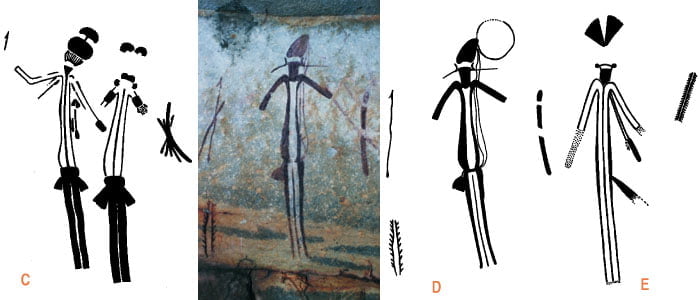
Most commonly this showed as a subtle trace of paunch line, occasionally coupled with even more subtle contours hinting at shoulder and thigh muscle detail. Traces of Paunch Detail can still be identified on the figures in ‘A’. A 740mm Tapering Outline Clothes Peg Figure retaining clearly defined Paunch Detail to its left side, as well as small waist-mounted Pubic Aprons to front and rear. The now vanished white forearms originally clutched a red spearthrower, identifiable in parallel alignment above the left arm, and a bundle of three upright Multi-Barb Spears, identifiable by red multi-barb sections surviving, to the upper right.
A pair of early semi-naturalistic forms of Tapering Outline Clothes Peg Figures. These show consistent waist-to-ankle use of solid red infill, which is often accompanied by small front and rear mounted Pubic Aprons (C). A 420mm semi-naturalistic form of Tapering Outline Clothes Peg Figure with long spearthrower and Nosebone Feature. These later semi-naturalistic forms abandon the dividing Centre Bar and extend the use of a contrasting infill colour from chest levels to include legs (D). Examples of the Tapering Clothes Peg Figures peak of graphic development. The figure ‘E’ shows the symmetry achieved by using a Centre Line to divide yellow infill segments enclosed by an outline.
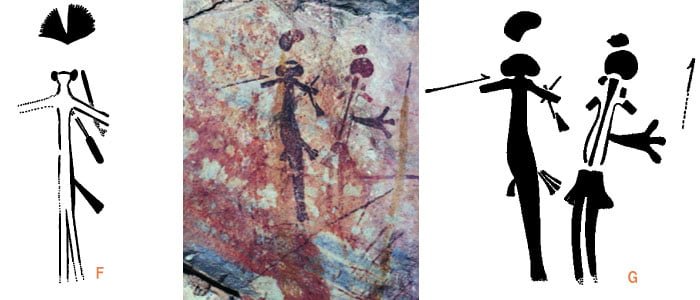
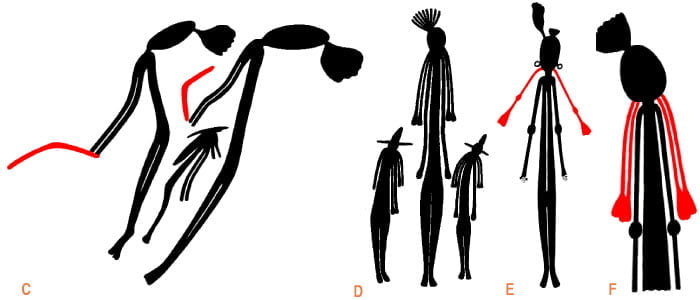
Subtle differences of arm and leg alignment in ‘F’ effectively reduce the visual impact attained by schematisation and simplified linework.
A pair of early Clothes Peg Figures (G) showing ‘straight-line’ limbs on semi-naturalistic torsos which retain the sweeping Paunch Detail line. The 360mm left figure displays the basic solid infill body, while the 330mm right figure shows an early form of Tapering Outline development. Early torso experiments include alternating bands of contrasting colours.
The above text and images are taken and adapted from Grahame L. Walsh’s 2000 publication, Bradshaw Art of the Kimberley.




